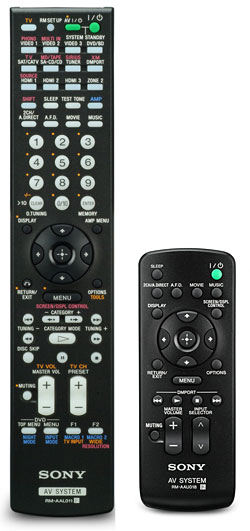Sony STR-DA4300ES A/V Receiver User Interface
 User Interface
User InterfaceI have never been a big fan of the remotes supplied with any of the AVRs I have reviewed or owned. They handle the basic functions well enough, but when it comes to operating your home theater system, nothing beats a third-party universal remote from companies such as Universal Remote Control, Logitech, or Philips. The remotes supplied with the 4300ES did nothing to change my opinion in this regard.
The main remote is certainly not the worst I have ever used, but I wouldn't exactly call it an engineering marvel, either. It is much too long and thin to operate all the functions with one hand, and most distressingly, it isn't backlit. The glow-in-the-dark keys lose their shine after about 15 minutes in a darkened room, but once you're familiar with the remote, finding the oversized volume buttons is easy enough to do by touch. Changing inputs in the dark proved to be a frustrating task because of the lack of a backlight and the way the input keys are clustered at the top of the remote.
Also supplied is a smaller, secondary remote that can handle the most common features of the AVR, and it easily fits into one hand. This remote is as basic as it gets, with no backlight or even glow keys, but if basic functionality is all you're looking for, it will fit the bill.
The GUI provided by this AVR is quite good; in fact, Sony was the first company to offer an icon-based GUI in an AVR. Inspired by the XrossMediaBar found on a lot of Sony products, including the PS3, navigating the user menus couldn't be any easier—as you scroll over each function, you see a description of what that function does.
However, all is not perfect with the GUI. If the receiver is connected to your display via HDMI and you press the Menu button, both audio and video are disabled, leaving you with only the interface on your display and no sound in your speakers. This prevents you from using an external source of test tones, such as a test disc like Digital video Essentials. You can disable this mode and display all the settings in the front-panel display, but for initial setup, using the graphic interface is much easier.






























































